Understanding the different cuts of pork can be confusing but we are going to help you with that! One question that I see all of the time is, “What is the difference between pork chops and pork steaks?“
Let’s get that question answered for you!
- Pork chops are cut from the loin section of a hog. The meat on a pork chop is usually lean with little intramuscular fat.
- Pork steaks are cut from the shoulder/butt section of a hog. The meat on a pork steak has a large amount of intramuscular fat and is very succulent.
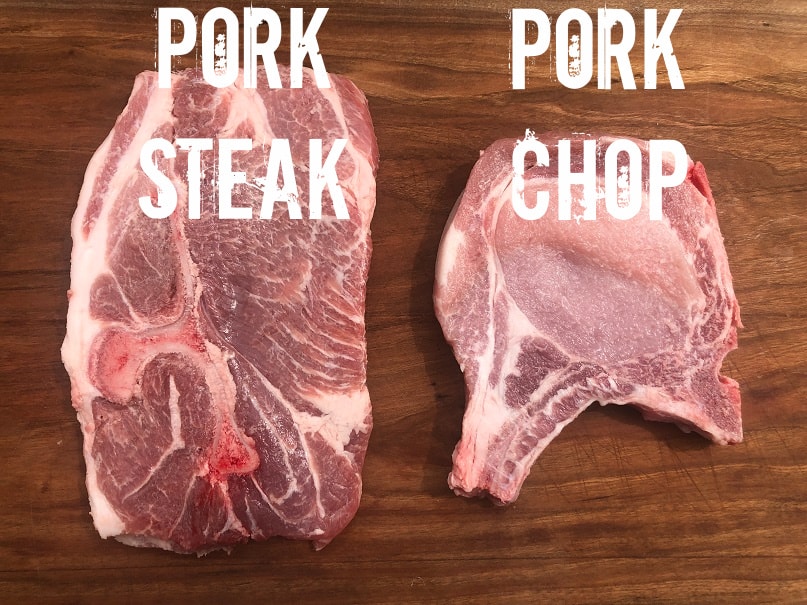
Let’s look at some of these, and other, differences in greater detail.
Location on Hog
The absolute biggest difference between these two cuts of meat is where they come from on the hog.
Pork steaks are cut from the shoulder, also known as the Boston Butt, of the hog. You can tell by the picture below that a butt has a high fat content and is composed of many different individual muscles.

The butt has an incredible amount of connective tissue and marbling throughout the meat. It is extremely common to use the butt to make pulled pork as the fat and collagen in the meat melt away to create beautiful juices.
There is also enough fat in a butt that many people use it for making sausages without the need for adding more fat.
In contrast, pork chops are cut from the loin section of the hog. While the loin does have a fat cap on the surface of the meat, the meat itself is very lean and dry with almost no intramuscular fat.
Here is a picture of a pork loin with the external fat cap removed that shows just how lean this meat is. The loin is so lean that it is the cut I use for making pork jerky.
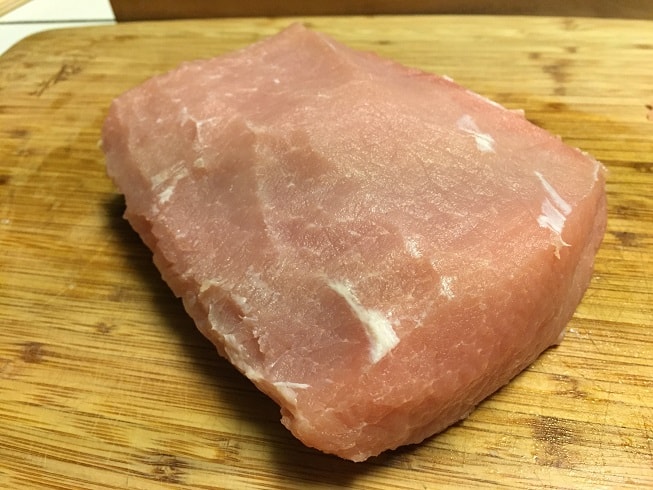
The following graphic, courtesy of Smithfield, is useful. The section labeled “Boston Shoulder” is where pork steaks come from while chops come from the Center Loin, Tenderloin and Sirloin regions.
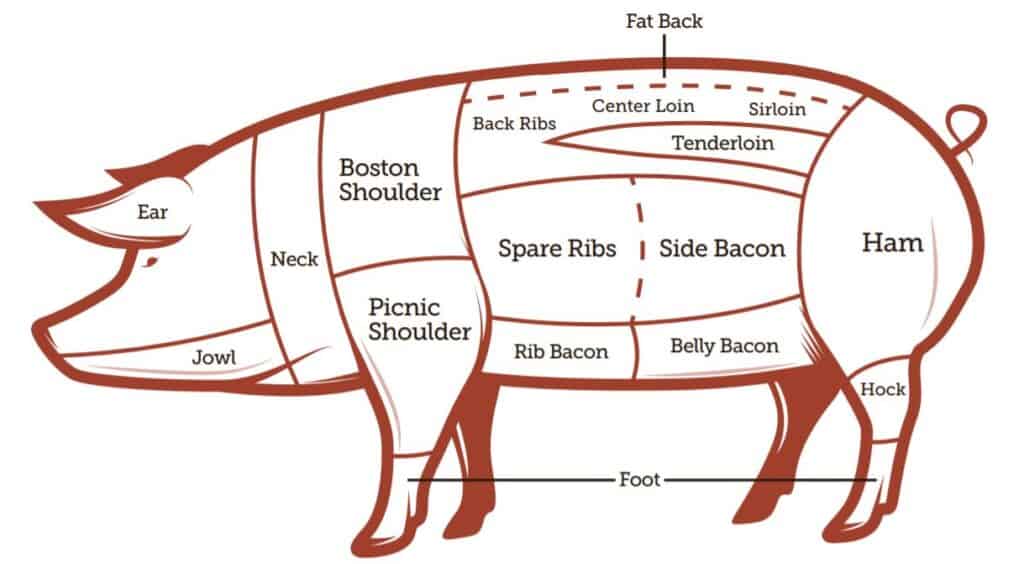
Nutritional Content
The nutritional content of these two cuts should not be surprising given the differences in fat content.
- Calories: Pork Steak = 210, Pork Chops = 193
- Protein: Pork Steak = 20g, Pork Chops = 24g
- Fat: Pork Steak = 14g, Pork Chops = 11g
If you are looking for the healthier option then the pork chop is what you want to get.
If you want flavor then the pork steak is the best choice.
Cost Differences
When it come to your wallet you will find pork steaks are more budget friendly than pork chops.
While absolute prices vary across the country and depend upon the particular grocery store, I have routinely found that, on a per pound basis, pork chops cost twice as much as pork steaks.
Pork steaks usually cost about the same as chicken drumsticks and that is cheap.
This is great news for me since I would rather eat pork steaks than chops any day of the week!
Differences in Cooking
At a fundamental level you can cook these two cuts exactly the same and they will turn out great. The key is to cook them to an internal temperature of 145F.
When they reach 145F they are safe to eat while still being tender and juicy. When you cook them past 145F they will dry out and toughen up.
On a practical level cooking pork chops can be harder than pork steaks and there are a couple tricks you can use to make sure they turn out amazing.
The Challenge with Cooking Pork Chops
They three biggest challenges of cooking pork chops are:
- Easy to dry out
- Lack of flavor
- Inconsistent cuts
Easy to Dry Out: The natural leanness of pork chops make them unforgiving if overcooked. Unless you are staying on top of things and measuring temperatures with a digital thermometer it is easy to overcook a pork chop and end up with a hockey puck.
This is especially true for thin cut chops.
Lack of Flavor: Lean meat is healthy but it does not bring a lot of flavor to the party.
Inconsistent Cuts: It can be tricky to master cooking pork chops because it turns out that “pork chop” is a generic term that covers several different cuts.
While a Pork Steak is always a Pork Steak, a “pork chop” can be many things. In a very ironic twist, chops are cut from the hog at an equivalent section as where steaks are cut from beef.
This means there are pork chops that have the same name and muscle structures as the most iconic beef steaks. There are Sirloin Chops, Ribeye Chops, New York Chops, Porterhouse Chops, etc.
As an example, here is a Porterhouse Pork Chop compared to a Ribeye Pork Chop.
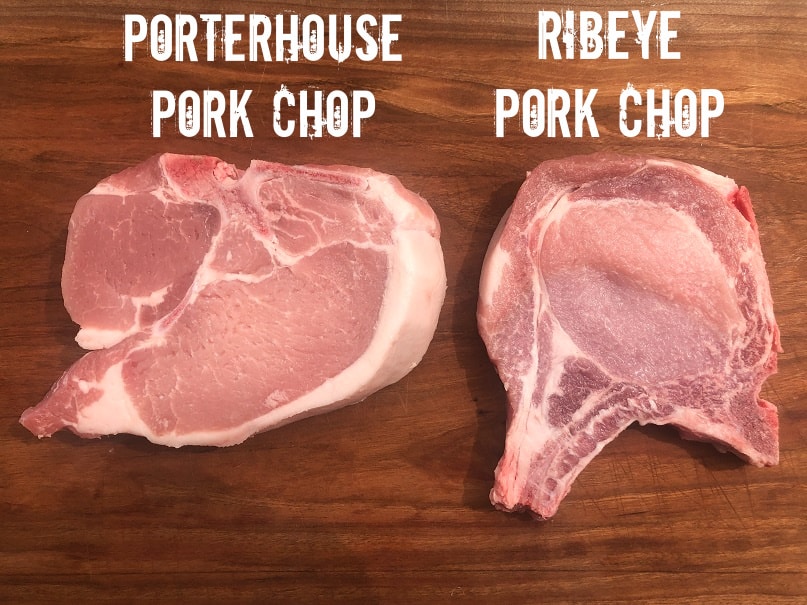
Most recipes for pork chops never mention what type of chop they are using.
If I were cooking beef steaks then I would not treat a Thick Cut Porterhouse the same as a Thin Cut Sirloin. Why shouldn’t we treat the equivalent cuts of pork the same as their beef counterparts??
This is one of the factors that makes finding a great pork chop recipe so difficult.
Making a great pork chop gets easier when you:
- Brine the chops to make sure they stay juicy even if slightly overcooked.
- Use bold marinades and dry rubs to pack on flavor.
- Pay attention to the type of pork chop you are cooking and make adjustments as needed.
Here is the package of chops that I used for grilling on my Weber Q1200. Note that many of the problems associated with cooking these chops was addressed by the meat processor. These chops were brined and pumped with flavor using salt, pork stock, phosphates and lactates.
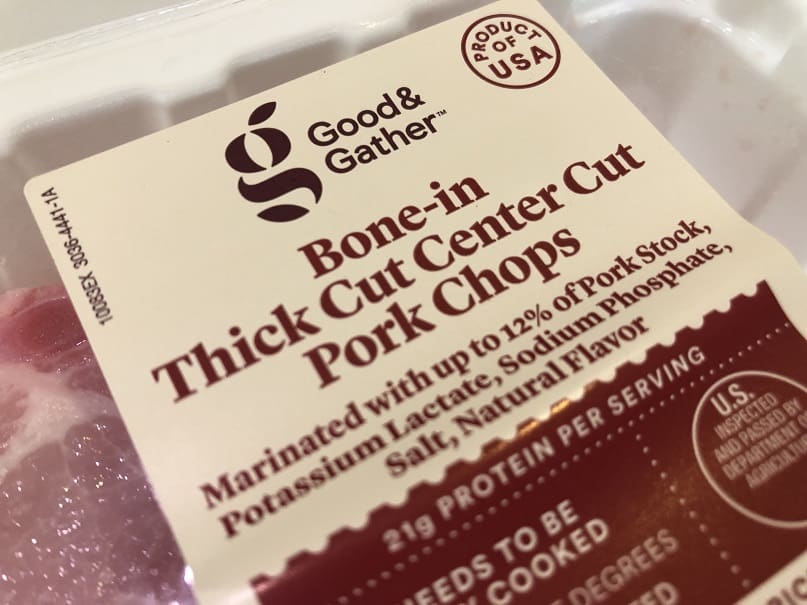
I am not saying that pork that is pumped with salt at the processor is what you need to look for, but I am pointing out the extremes people will go through to make sure this cut of pork is juicy and flavorful.
Here is a look at how I cooked some pork chops on my Z Grills pellet grill. I packed on the flavor with a great dry rub and used a digital thermometer to make sure that the chops did not overcook.
Here is an alternative recipe for smoked pork chops using a sweet chili glaze.
Cooking Pork Steaks
There is so much natural flavor in a pork steak that you can just hit it with salt and pepper and sear it in a skillet and end up with a great meal.
If you do end up overcooking the steaks a little it isn’t a big deal since all of the intramuscular fat provides a layer of protection against drying out.
That being said, pork steaks are great vehicles for accepting a bold flavor package and can be turned from Great to AMAZING with just a few extra steps.
Here is a look at how I prepared some simply incredible pork steaks on my Weber Q1200.


